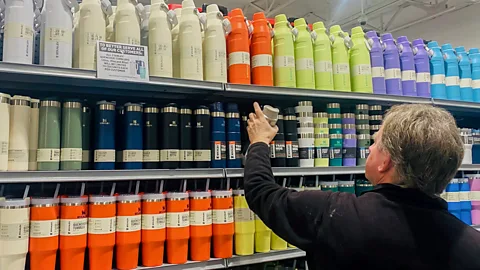Stanley cups contain lead – should we be worried about exposure?

After Stanley fans posted home lead test results on social media, the company confirmed the viral insulated tumblers do contain lead. Here’s what experts are saying.
Stanley, the makers of the tumblers that have become a viral sensation, have come under scrutiny this week. Social media users, specifically on TikTok and Instagram, have been sharing videos showing at-home lead test findings, and the results are worrying faithful Stanley sippers.
Dozens of consumers are posting videos claiming that their tumblers tested positive for lead. It's often unclear from the videos which or how many different brands of at-home lead tests these consumers are using, but to be EPA-certified, home lead tests such as D-Lead must produce an accurate result (when used correctly) 95% of the time. At-home lead tests for drinking water are less reliable.
In response to the claims, Stanley issued a statement about lead in its product.
"At Stanley, one of the key features of our products is our vacuum insulation technology, which provides consumers with drinkware that keeps beverages at the ideal temperature," the company wrote on its website, acknowledging that lead is used in the manufacturing process. The statement continues, "Once sealed, this area is covered with a durable stainless steel layer, making it inaccessible to consumers. Rest assured that no lead is present on the surface of any Stanley product that comes into contact with the consumer nor the contents of the product."
The BBC reached out to Stanley for additional comment and they responded with the same statement available on their website. The online statement concludes that Stanley products "meet all US regulatory requirements".
What consumers need to know about lead content in drinkware
How much should consumers worry about lead in products, especially those used for eating and drinking? Lead exposure has well-documented health consequences, especially for children. According to The World Health Organization (WHO), "There is no known safe blood lead concentration", and even miniscule amounts found in blood "may be associated with decreased intelligence in children, behavioural difficulties and learning problems".
According to the Centers for Disease Control and Prevention (CDC), lead exposure can also lead to growth, hearing and speech problems and damage to the brain and nervous system. And in adults, lead exposure can lead to high blood pressure, cardiovascular issues and more. It's dangerous for pregnant persons because lead can be transferred to a developing foetus, and is also associated with a high risk of miscarriage. Additionally, lead poisoning can be fatal.
Thankfully, federal and state laws in the US have drastically helped lower the amount of lead people are exposed to, but it’s still found in some products. The most common place it's still found is in lead-based paint in homes that were built before 1978 (when such paint was banned). The CDC now tracks lead-related product recalls. In the UK, lead pipes were banned in the 1970s but the sale of lead paint wasn’t banned until 1992.
When it comes to the lead in Stanley cups, however, experts aren't too concerned. Jack Caravanos, a professor of public health at New York University who studies the effects of lead exposure, tested three of the cups himself and came up with no lead. He even said he tried to pry the cup open to test the inside, and failed.
"There appears to be lead, according to the report," Caravanos told the BBC, "but I had trouble detecting it and wasn’t able to detect it using state-of-the-art equipment." He says this is probably because the lead was "too deep inside the unit", meaning it would be very tough to be exposed to it or ingest it.
He added that while he’s not worried about drinking from his own Stanley, he also takes issue with the fact that companies still use lead to manufacture their products at all, and mentioned that under Proposition 65, products sold in California need to disclose if they contain even trace amounts of lead. Stanley's brand FAQs state that "all Stanley items comply with Prop 65 and FDA requirements."
Patty Davis, press secretary for the US Consumer Product Safety Commission, says that while she can't comment on the lead in Stanley products, similar products from other companies with "excessive levels of lead", such as a kids' cup sold on Amazon by Klickpick, among others, have recently been recalled.
"We ask consumers to report incidents or safety concerns with consumer products to CPSC at www.SaferProducts.gov. They can also search for product recalls there," she told the BBC.
